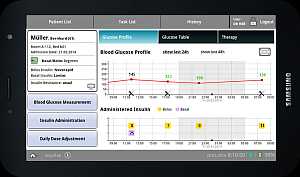The final REACTION platform is composed by 22 components that can be assembled in various ways to target the needs of different users in the very wide domain of diabetes management.
The components listed below offer solutions for point of care, patient loops, glucose sensors, online services, caregivers, models and software infrastructure. You can also find them in the REACTION catalogue
REACTION GlucoTab
 The GlucoTab is a workflow and insulin dosing support system for glycaemic management of hospitalised patients with diabetes. It implements a novel, mobile, tablet-based workflow support system for nurses and physicians at the ward which includes a validated basal/bolus insulin titration protocol (REACTION algorithm).
In REACTION, the GlucoTab system was validated in two clinical trials involving a total of 129 patients. Results show a decrease of the mean blood glucose, no increase of hypoglycaemic events and a high user acceptance. The GlucoTab system was CE marked in November 2013 and can now be used in a clinical routine. The GlucoTab is a workflow and insulin dosing support system for glycaemic management of hospitalised patients with diabetes. It implements a novel, mobile, tablet-based workflow support system for nurses and physicians at the ward which includes a validated basal/bolus insulin titration protocol (REACTION algorithm).
In REACTION, the GlucoTab system was validated in two clinical trials involving a total of 129 patients. Results show a decrease of the mean blood glucose, no increase of hypoglycaemic events and a high user acceptance. The GlucoTab system was CE marked in November 2013 and can now be used in a clinical routine.
REACTION Patient Portal
 The patient portal is a web application designed to enable sharing of information between clinicians and patients and to support the patients and informal carers in the self-management of the diabetes. It promotes patient’s empowerment and allows for collection of patient input data and allows the visualisation of collected measurements, educational contents and care plan.
In REACTION the patient portal was validated in a clinical field trial involving a total of 107 patients with home monitoring equipment installed. Satisfaction with both the equipment and patient portal was high. Patients appreciated the feedback concerning their measurements and how to interpret the results. The patient portal is a web application designed to enable sharing of information between clinicians and patients and to support the patients and informal carers in the self-management of the diabetes. It promotes patient’s empowerment and allows for collection of patient input data and allows the visualisation of collected measurements, educational contents and care plan.
In REACTION the patient portal was validated in a clinical field trial involving a total of 107 patients with home monitoring equipment installed. Satisfaction with both the equipment and patient portal was high. Patients appreciated the feedback concerning their measurements and how to interpret the results.
REACTION Clinical Portal
The clinical portal is a web application for managing information collected from sensors, patient portal and care plan in order to provide clinical management of diabetes patients.
In REACTION, the clinical portal was validated in the same clinical trial as the patient portal. The clinicians found it helped identify patients in need of intervention, engage patients in managing their condition, support clinical decision making and improve control and compliance.
The results from the clinical study in primary care will be available for download once they have been approved by the European Commission in April 2014 (link to downloads)
REACTION Multi-Protocol Home Monitoring Gateway
 The gateway is a software-based gateway running on a standard PC-platform with or without user interface. It provides uniform access, connectivity, control and interfacing with medical and wellness devices. It supports Continua© and other protocols and exports data to different back-ends. The gateway is a software-based gateway running on a standard PC-platform with or without user interface. It provides uniform access, connectivity, control and interfacing with medical and wellness devices. It supports Continua© and other protocols and exports data to different back-ends.
REACTION ZigBee Home Monitoring Platform
The platform is a mains plug mounted home gateway with ZigBee local wireless network and GPRS WAN sending data from ZigBee enabled sensors to back-end database.
REACTION Device Connectivity Kit (DCK)
The DCK is a developer toolkit for integrating medical devices into eHealth applications. It includes APIs, extensible middleware objects for device connectivity and testing tools for protocol compliance. Using the Reaction DCK, the developers will increase efficiency and be able to quickly deliver new eHealth solutions.
REACTION Platform Server Backend
The server back-end is software running on back-end server on top of one or more databases. It processes incoming observations from various gateways. It provides functionality for defining and executing monitoring rules and related actions such as SMS notifications. The software also provides functionality for defining and executing service orchestrations and event processing and management. A layer of Web-Services provides a high level Service Layer for applications to access and process patient and monitoring data.
REACTION Nutrition App
The nutrition app is a Smartphone app for entering nutrition information, providing access to and selection of nutrition data such as carbohydrates and calories. The app exports data to a back-end server. It stores dietary information and weekly lists of meals and can export into the REACTION database using the Service Layer. Click on the image below to see a video demonstrating the app.

REACTION SMS Notification Component
The component is a software infrastructure for the delivery of SMS notifications. It is provided as a service that can be accessed through a specific API.
REACTION Network Monitoring Service for Mobile Devices
The service is a Java library for remotely monitoring/managing mobile devices using the Simple Network Management Protocol.
REACTION Long-term Risk Models
The service is a web service component for clinicians that implements statistical models for predicting the occurrence of specific diabetes complications, identifying the relevant sets of risk factors of each diabetes complication and exploiting the Bayesian networks in order to depict the statistical relations among diabetes-related clinical parameters.
REACTION Glucose-Insulin-Glucagon Model
The model describes the glucose insulin metabolism, both for people with diabetes and for people without, and allows gaining a better understanding of processes involved in maintaining glucose homeostasis. It also provides a prediction kernel to create closed loop glucose control algorithms.
REACTION IR Continuous Glucose Monitoring Sensor
 The sensor is based on infrared (IR) difference absorption spectroscopy applied either with a perfusion solution generated via microdialysis (chip-based type) or directly into a micro-needle acting as body interface (fibre-based type). The sensor is based on infrared (IR) difference absorption spectroscopy applied either with a perfusion solution generated via microdialysis (chip-based type) or directly into a micro-needle acting as body interface (fibre-based type).
REACTION I-Cath Sensor
The sensor is a luminescence-based continuous glucose monitoring device. The measurement principle is based on the effect that oxygen quenches the luminescence of the applied luminescent agents which is measured as the luminescence phase shift in the frequency domain by the optical module.
Wireless Sensor (ePatch) for Heart Rate Monitoring
The ePatch® is a miniaturised system for monitoring vital physiological signs, applied to the skin surface with a skin friendly adhesive. The ePatch primarily records ECG but in REACTION the technology has been further developed towards the needs in diabetes treatment. Activity sensors and wireless data communication using ZigBee or Bluetooth have been integrated, and the technology has been further developed and matured in general so it is reliable, easy to use and can be manufactured at affordable prices.
REACTION Short-Term Risk Management (STRM) Tool
The tool is used to control the adjustment of the care plan in a cyclic process way, based on a pattern management approach.
REACTION Semantic Search Tool
The tool enables the user to search for information from databases. It strengthens the functions of the Short-Term Risk Management Tool in finding heterogeneous patterns in the history of the actual patient, similar cases and relevant information materials.
REACTION Closed-loop Algorithm
The algorithm provides insulin dose suggestions based on frequent glucose measurements (intravenous or subcutaneous) to improve glycaemic control. The algorithm relies on the mechanistic Glucose-Insulin-Glucagon Model as a core for model predictive control that is further embedded into a PID-based off-set control for prediction error correction.
REACTION Primary Care Patient Monitoring Protocols The protocols are used to optimise the support of the clinical management of patients in the primary care and home care environment. They support the clinician in the management of patients in a way that reduces the burden of reviewing patient data, identifying those patients at risk and induce timely intervention.
REACTION Security Framework
A framework for securing communication between Android devices and web services, controlling access to web services based on roles and security tokens (e.g., identity certificates), validating security tokens, and managing user information.
REACTION Database
The database is a data model (implemented as relational database) specifically designed and implemented to take into account the data requests of different REACTION components. The database is built in SQL Server 2008 and data are managed by the Store Procedures which are managed by the Web Services.
REACTION Notification Handler
The notification handler is a tool allowing professional staff to assign alerts/ notifications based on patient data from sensors. This application allows clinicians to react ubiquitously to change in the patients’ health state and/or environment; perform pre-defined activities or notifications handling according to pre-programmed rules or through closed loops involving formal and informal carers and combine the orchestration of services with an underlying efficient networked-based event management solution.
Read more about the products in the project catalogue
to
the top  | 


 Based on an iterative process of gathering user requirements, the REACTION platform and components were designed, developed and integrated in two different health environments: The University of Graz in Austria with focus on monitoring and decision support to healthcare professionals, and the primary care environment at Chorleywood Health Centre in the UK with emphasis on management and therapy services to patients with diabetes.
Based on an iterative process of gathering user requirements, the REACTION platform and components were designed, developed and integrated in two different health environments: The University of Graz in Austria with focus on monitoring and decision support to healthcare professionals, and the primary care environment at Chorleywood Health Centre in the UK with emphasis on management and therapy services to patients with diabetes.  In the primary care setting, patients were able to use REACTION technology to monitor vital signs and communicate them to the healthcare centre. This made patients more aware of their condition and facilitated a more informed interchange with healthcare professionals concerning their therapy and behaviour.
In the primary care setting, patients were able to use REACTION technology to monitor vital signs and communicate them to the healthcare centre. This made patients more aware of their condition and facilitated a more informed interchange with healthcare professionals concerning their therapy and behaviour. The GlucoTab is a workflow and insulin dosing support system for glycaemic management of hospitalised patients with diabetes. It implements a novel, mobile, tablet-based workflow support system for nurses and physicians at the ward which includes a validated basal/bolus insulin titration protocol (REACTION algorithm).
In REACTION, the GlucoTab system was validated in two clinical trials involving a total of 129 patients. Results show a decrease of the mean blood glucose, no increase of hypoglycaemic events and a high user acceptance. The GlucoTab system was CE marked in November 2013 and can now be used in a clinical routine.
The GlucoTab is a workflow and insulin dosing support system for glycaemic management of hospitalised patients with diabetes. It implements a novel, mobile, tablet-based workflow support system for nurses and physicians at the ward which includes a validated basal/bolus insulin titration protocol (REACTION algorithm).
In REACTION, the GlucoTab system was validated in two clinical trials involving a total of 129 patients. Results show a decrease of the mean blood glucose, no increase of hypoglycaemic events and a high user acceptance. The GlucoTab system was CE marked in November 2013 and can now be used in a clinical routine. The patient portal is a web application designed to enable sharing of information between clinicians and patients and to support the patients and informal carers in the self-management of the diabetes. It promotes patient’s empowerment and allows for collection of patient input data and allows the visualisation of collected measurements, educational contents and care plan.
In REACTION the patient portal was validated in a clinical field trial involving a total of 107 patients with home monitoring equipment installed. Satisfaction with both the equipment and patient portal was high. Patients appreciated the feedback concerning their measurements and how to interpret the results.
The patient portal is a web application designed to enable sharing of information between clinicians and patients and to support the patients and informal carers in the self-management of the diabetes. It promotes patient’s empowerment and allows for collection of patient input data and allows the visualisation of collected measurements, educational contents and care plan.
In REACTION the patient portal was validated in a clinical field trial involving a total of 107 patients with home monitoring equipment installed. Satisfaction with both the equipment and patient portal was high. Patients appreciated the feedback concerning their measurements and how to interpret the results. The gateway is a software-based gateway running on a standard PC-platform with or without user interface. It provides uniform access, connectivity, control and interfacing with medical and wellness devices. It supports Continua© and other protocols and exports data to different back-ends.
The gateway is a software-based gateway running on a standard PC-platform with or without user interface. It provides uniform access, connectivity, control and interfacing with medical and wellness devices. It supports Continua© and other protocols and exports data to different back-ends.
 The sensor is based on infrared (IR) difference absorption spectroscopy applied either with a perfusion solution generated via microdialysis (chip-based type) or directly into a micro-needle acting as body interface (fibre-based type).
The sensor is based on infrared (IR) difference absorption spectroscopy applied either with a perfusion solution generated via microdialysis (chip-based type) or directly into a micro-needle acting as body interface (fibre-based type).

